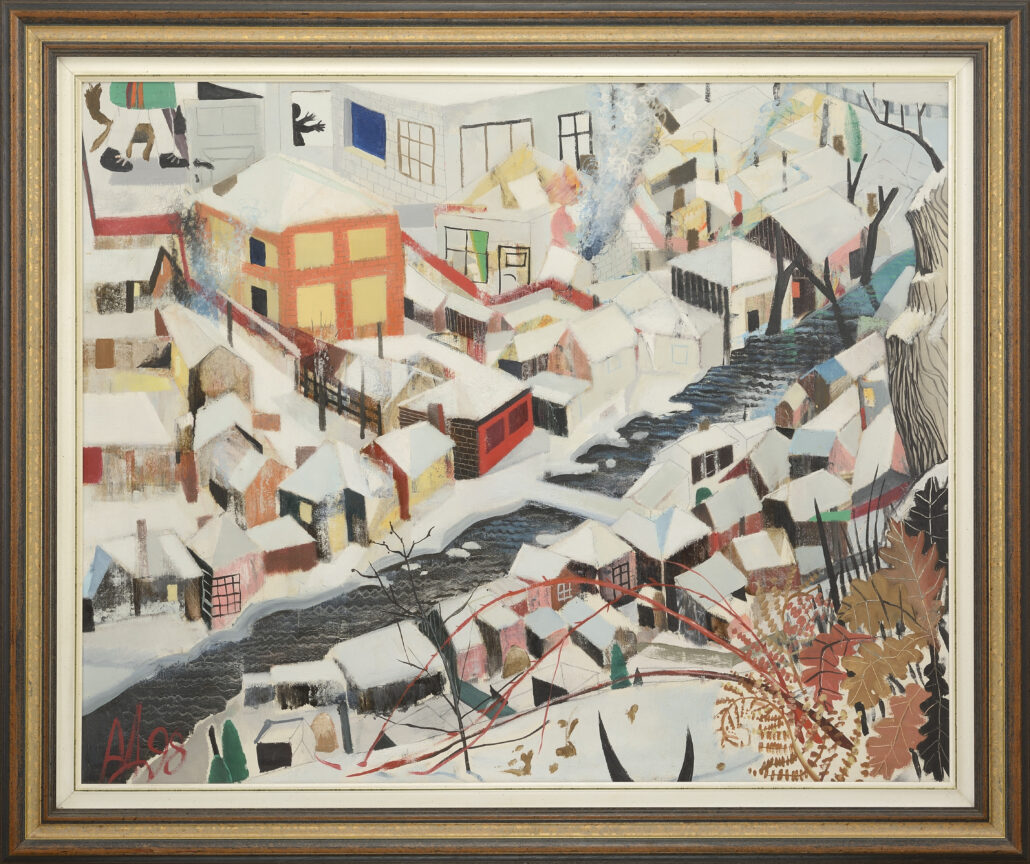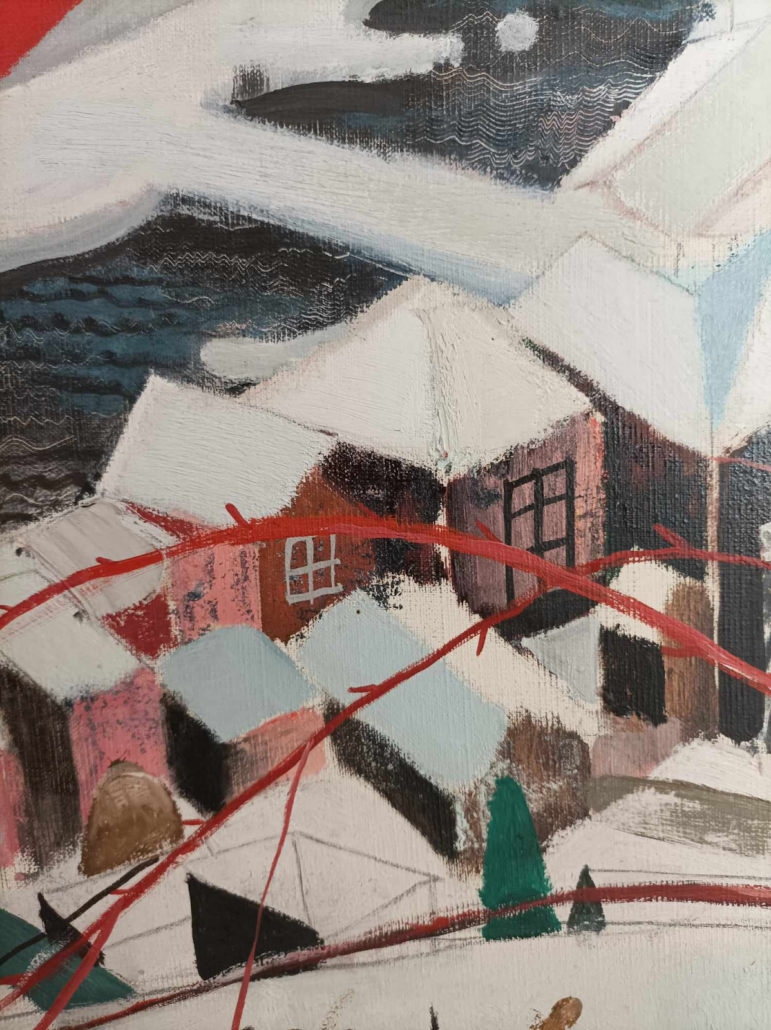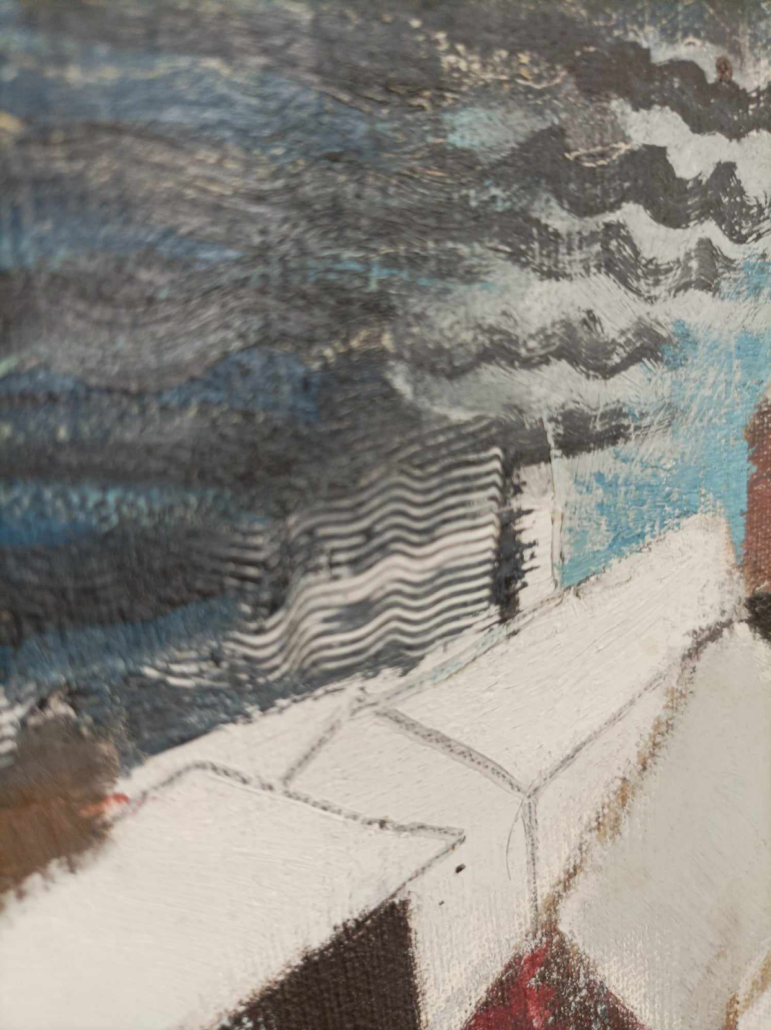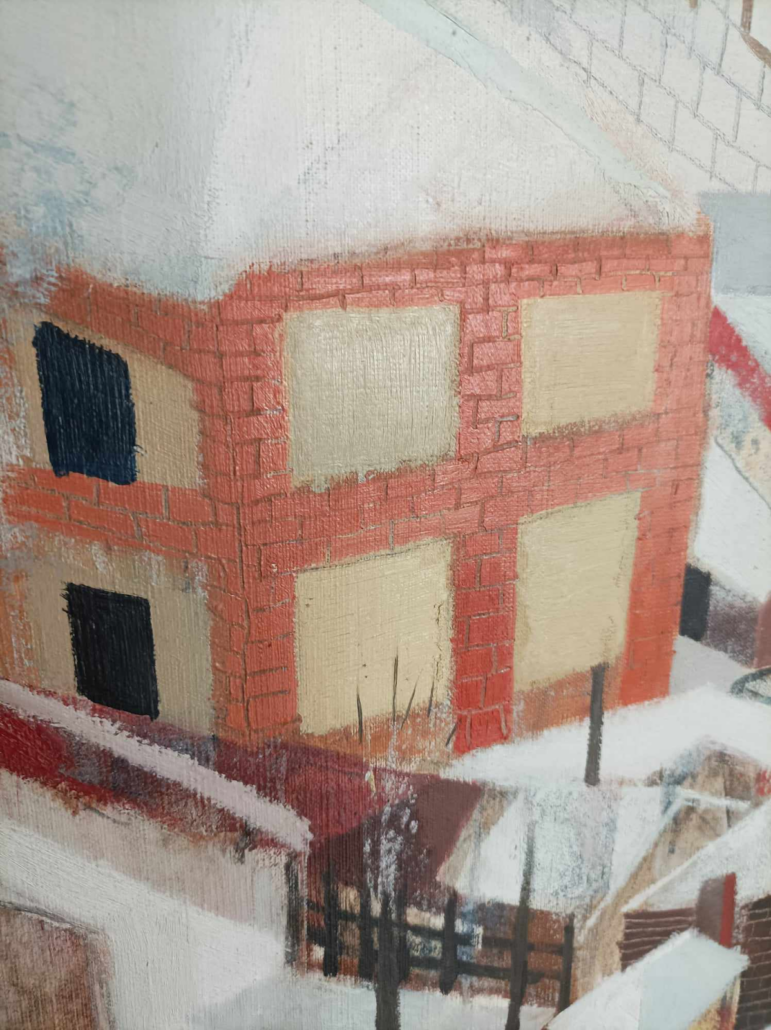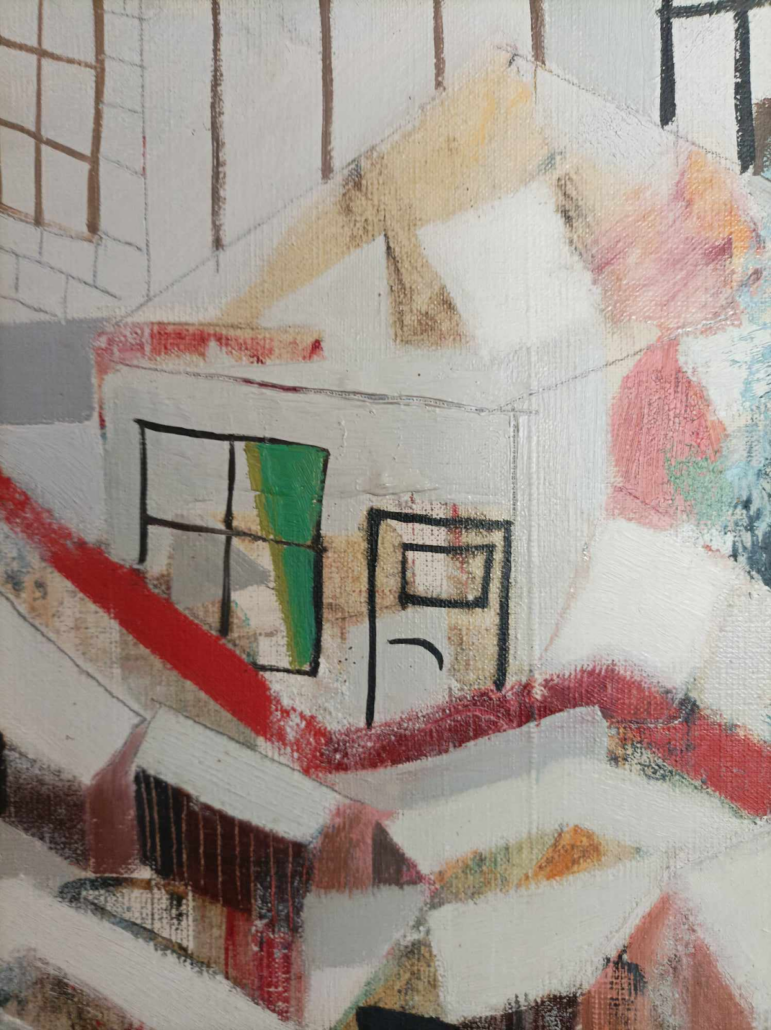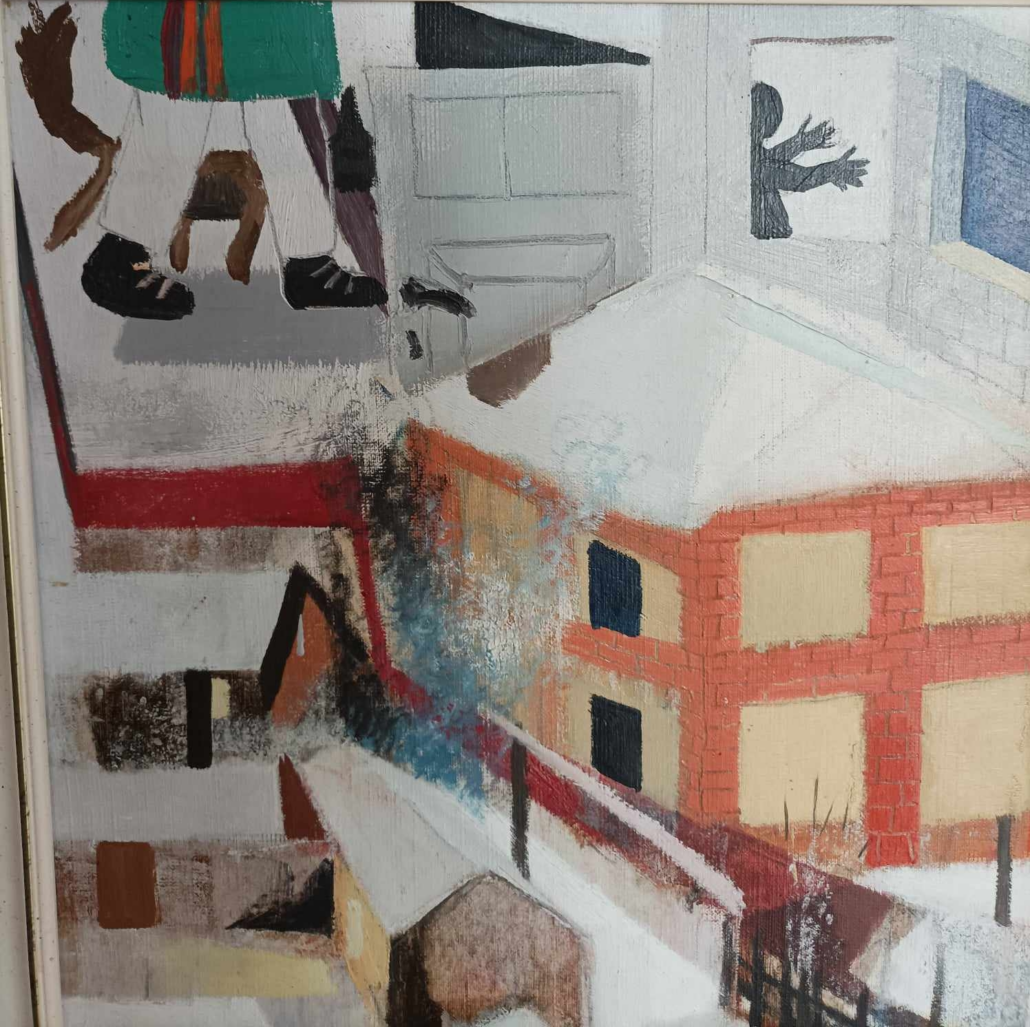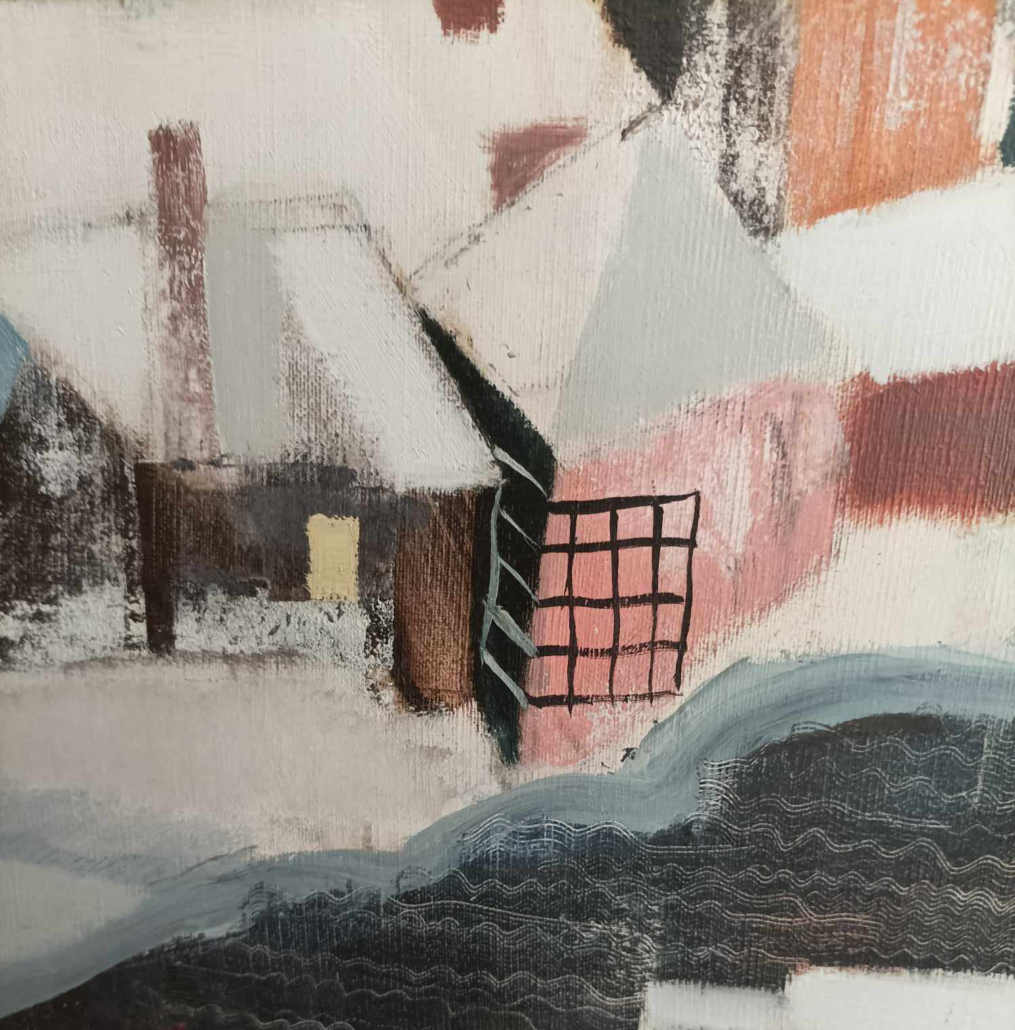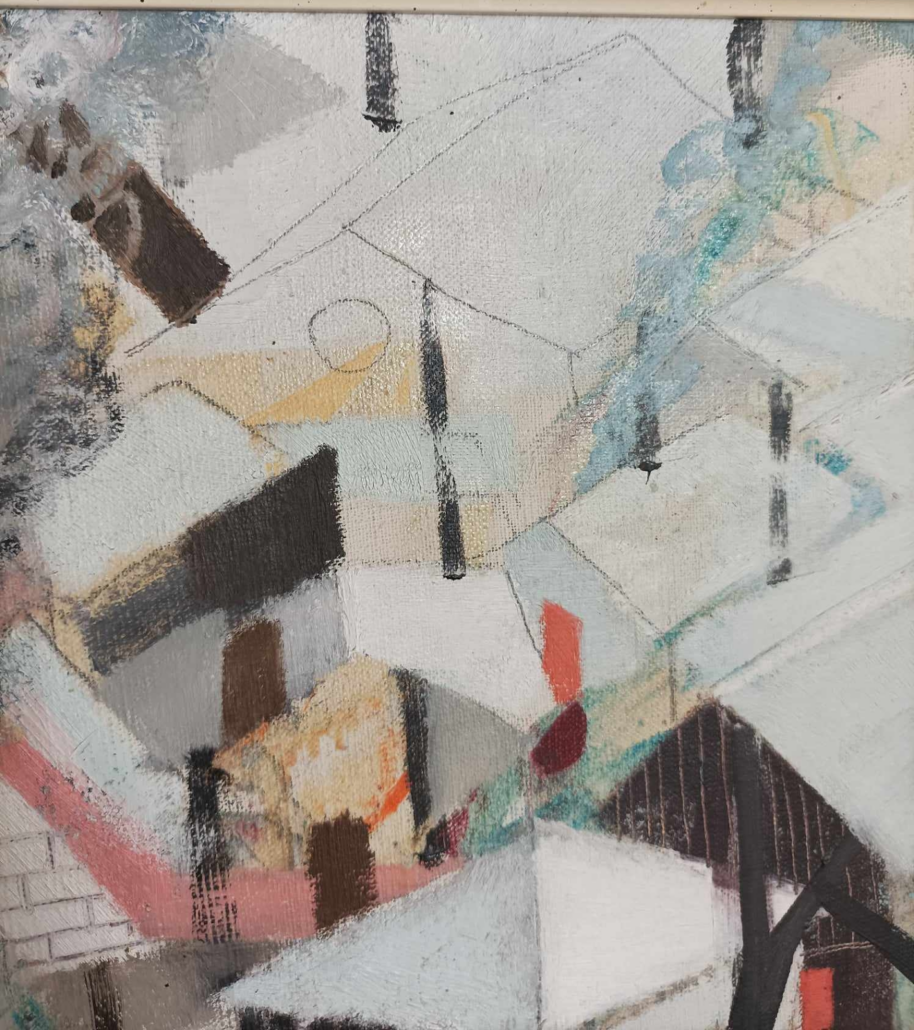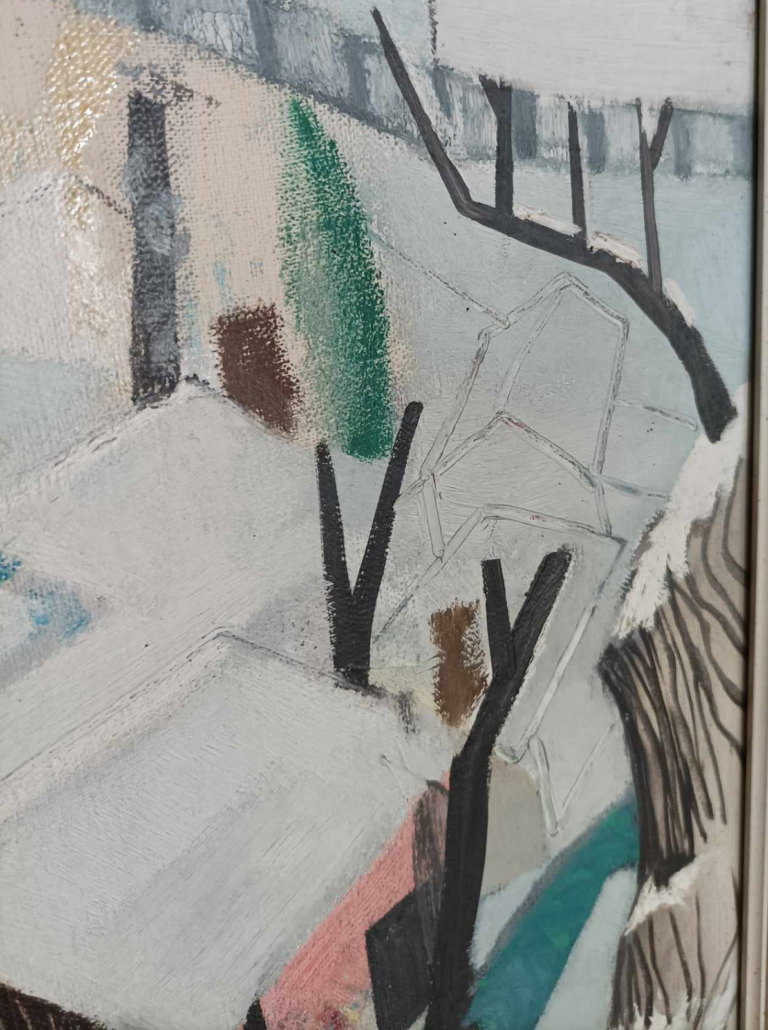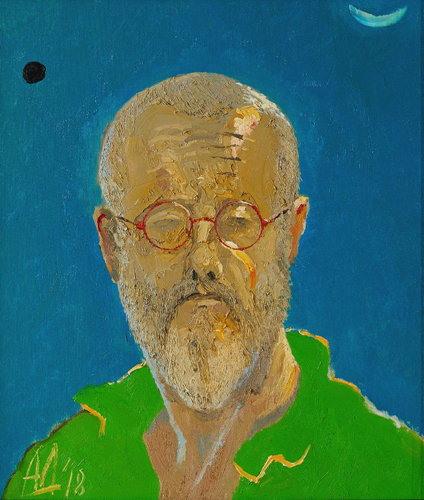After the story told in the first part of the text, about the creation and documentation, we continue with the analysis of the most valuable jewel (according to the author of the text) among the works of fine art in the Spring Auction 2024 – the work by Andrey Daniel (1952-2020) “Landscape from Lessidren I”, 1998, oil on canvas, 81×100 cm.
Landscape from Lessidren I
Andrey Daniel has observed the winter Lessidren from high above and from the nature, probably from the “House of the Cinematographers”, where the artists resided, during the first plein air workshop of the Lessidren Gallery in 1998. Despite the high and distant viewpoint, the painting is full of dozens, perhaps hundreds of tiny details that are virtually impossible to be perceived by the eye from afar. When we look at them, we realize that the landscape is somehow both realistic and fantastic, fairy-tale-like, as if seen in a dream, in which dream you recognize without a doubt that you are seeing the particular place, even though it is quite unlike the place you know when you are awake. This is the first mastery of Andrey Daniel that I will note in my analysis.
The nature-culture opposition is drawn out in the invisible diagonal between the leaves and branches of trees at the bottom right, and the huge houses with the painted images at the top left. The nature in between is represented only by cropped trees, and the culture – by small houses. There are no full-fledged, living human figures to represent the nature-culture fusion. The time in the painting is specially picked – the small hours of the night, when everyone in the village is asleep. The playfulness is that Lessidren is being dreamt during the sleep of Lessidren people. There are no street lights, the light of the culture is almost missing – there are only a few glowing (yellow) windows. The light in the painting is entirely natural, coming from the reflection of the probably full moon by the thick snow covering everything.
The visible diagonal that divides the culture-village world in two is natural – the flow of the black-blue Lessidren River contrasting with the white-bluish snow. A bridge in the centre of the composition connects the two halves of the village. It is the key stone that holds the composition from falling apart. Daniel’s mastery has made it so that the black river at night is also a source of light. Through the densely scratched transverse waves, unusual for a river, lower layers of white and blue peek through, representing in a fantastical way the reflection of the night sky blue and the glare of the full white moon, which is not depicted on the painting. Warm focus is brought through the realistically constructed small red and huge yellow and orange house in the upper half of the village. Next to them lies a fairy-tale-like white and pink house with transparent walls, painted window and door.
What accounts for the fantastic nature of the landscape? The fact that almost every house is seen from a different perspective. The most convincing in this respect is the huge chimney belching thick grey-white-bluish smoke in the middle of the composition, which stands unrealistically out of balance and proportion against the surrounding buildings. Another more noticeable fantasy is the inverted perspective – the nearest houses in the bottom right are small, while the most distant ones in the top left corner are huge. In the other pieces, the oddities of perspective are hardly noticeable at first glance – the lit and dark parts are in different areas on the houses, elsewhere the laws of perspective are slightly broken. There are no shadows, but there are reflections in the river. It is as if Andrey Daniel was looking with a hundred eyes, or jumping from place to place, or climbing up and down the slope, or using a drone to paint each individual object. Moreover, since that was not practically possible at the time, I think it was only possible during sleep, in which space the mind can dart with great speed in all directions.
In addition to the fantastically constructed cultural space, the dream is clearly signified by the piece of black human shadow that is painted behind a window on the top left. It has the characteristic pose in which we imagine the lunatic, who while sleeping gets up and walks around with his arms stretched forward. Behind the lunatic, there is a large open door, which seems to have been opened by him in his passage from the bedroom to another room. However, it is not so, for outside the open door, there is a passage, and behind the passage, there is a wall on which a large mural is painted. We can only see the bottommost piece of the mural – a man’s legs just above the knee. He is wearing black shoes, white trousers and a long green outer garment reaching to below the knee, decorated with one red and two orange vertical lines, perhaps a scarf. A fox accompanies the man, which we can clearly identify by the shape of its tail and its brownish ochre colour. If this is not a mural, then it appears that a giant is heading to enter through a doorway that reaches just above his knee in height – another paradox and absurdity that we often see in dreams.
Another point characteristic of our visualizations during sleep is noticeable – the elements of the three-dimensional objects are two-dimensional, drawn in a very simple linear way. Such are most of the windows, doors and bars in Daniel’s landscape. Some houses are entirely linearly outlined, while others are almost invisible, just scratched into the three-dimensional white ground. The tricky thing, the game that the artist draws us into, is that unlike a dream, in which we enter a very realistic three-dimensional space, here we are actually dealing from the start with a pictorially painted two-dimensional canvas, in which many of the house-objects are two-dimensionally outlined and additionally their elements are again two-dimensionally delineated. From a distance, the composition creates the illusion of an almost completely realistic three-dimensional space. It is only when you bring your eyes close to the canvas, that you realize you are looking at a three-dimensional house with a linearly outlined door and windows. The look as if decorated (Marinska 1997: 148) with doors, windows, bars, even bricks. Just as it often happens in dreams.
Through this magnificent painting, Andrei Daniel tells us and demonstrates us by many means that the creative process takes place as if in a dream, in some other world, similar to the real one, but also different from it. He tells and demonstrates that creativity is a dream that man is able to bring into embodiment and produce in reality – not only mental, but also physical, material.
The Artist-Intellectual
We know that Andrey Daniel treasures paradox, absurdity, irony, the playing (Daniel, Andrey, 2010) and in this painting of a “most ordinary” landscape, we see the mastery with which he expresses these values visually. Why does he succeed? First, because he likes to observe, to contemplate for hours the most ordinary things (Daniel, Andrey, 2017; Vassilev, Kiril 2017). Again, in his own words, “The painter, as an artist, is embodied in the objects he creates on the canvas, for example the pen.” (Daniel, Andrey, 2010). Certainly, Daniel has embodied the houses, the river, the wobbly chimney, and the shadow of the lunatic to create this highly convincing yet fantastical, highly playful, funny and beautiful unreal reality.
What is different about Andrey Daniel’s dream world, when compared to the other artists featured in the auction with the same theme, is the rationalism, the accessibility of the subconscious to the mind, and the mind’s control over the subconscious. In the presented landscape from Lessidren, seen in a dream, irrationality is almost absent, there is almost no unknown and incomprehensible, no monsters, threats and fears, no unprocessed traumas. There is only a beautiful, exquisitely rational, fantastically ordered, dream-play tale, into the exploration of which we immerse ourselves with curiosity, confidence, peace and pleasure. It is an intellectual’s dream. For Andrey Daniel, the dream is not a stage for the unleashing of the instinctively frenzied, naturally-biologically-programmed human unconscious, but a stage for the unleashing of intellectual creative projects for a possible future world of culture.
According to what Andrey Daniel has shared about his creative process, he always paints things from life, as is the case here, but not as they are, but as they can be. (Vassilev, Kiril 2017) This is perhaps one of the sought-after and often applied types of paradoxicality in his work, which he also says is something fundamental. For him, fine art, and painting in particular, is fundamentally conceptual – creating the human world, the world of culture as opposite to nature. Thus, although he is, as he himself admits, a non-believer, his works always seem to some extent alien, located in other worlds, somehow supernatural. Such a supernatural world is in fact the world of culture in relation to the physical world of nature, as this supposedly ordinary landscape from the sleeping winter of Lessidren in 1998, beautifully shows us visually.
Listening to a video recording of a lecture he gave on conceptuality in fine art (Daniel, Andrey, 2010), I was extremely impressed that he had a deep insight and scientifically grounded understanding of the neuropsychological side of artistic work, of the biology of culture. Daniel is fully aware of the cultural role of the painter as a demiurge of the human world. He describes the painter as a creator of models for a world that can become reality, can be brought into being.
He understood perfectly the other main functions of art – the cognitive, social and empathic: “Painting, like all other arts, is a method of cognition. Through it we come to know some things about ourselves and the world to a greater extent” (Daniel, Andrey, 2017). “And if we do not learn to make meaning, to synthesize meaning for ourselves and for others, for very large groups of people, then this existence will be rather a kind of vegetation. Like a plant, we will sprout and die without having understood what it is all about. In that sense, people who are involved in art, I think, have this task of synthesizing meaning and from there getting motivation to live, motivation to work, in others, in everybody, getting that optimistic moment in the whole human tragedy that is” (Dzhambazov, Stefan, Zelma Almalekh, 2022).
Daniel often talks about the educational function of art, which builds moral concepts in the character of the individual (Daniel, Andrey, 2017). He has embodied these views in practice in the several decades he has devoted to establishing and cultivating his school with art academy students. Because of these views and the behavioural model he practiced, I name Andrey Daniel an artist-intellectual, as many Bulgarian artists were before the Soviet occupation, as we quite rarely found in the generations of Socialism and not at all nowadays.
Daniel speaks quite directly about his understanding of the elitism of fine art (Vassilev, Kiril 2017): “… for me fine art is very different (compared to theatre and cinema). I use the metaphor that the Lord God created everything from dust. Out of one material, He created both the living and the non-living, the transparent and the opaque, animals and man. How is it possible to create all these things out of one substance? Well, the artist who makes this kind of paintings can do it. The degree of conventionality creates the possibility of elevating intellectual contact, of communication. This conventionality must be high and requires a certain education. So I came to the conclusion that art is an elitist work.“
A masterpiece that visually represents almost all aspects of these concepts and values is on offer at the Enakor Auction House’s 2024 Spring Auction. The masterpiece has a chance to find the right home where Andrey Daniel’s conversations on nature-culture, the human-demiurge, the playing intellectual, and the synthesis of meaning through visual imagery are valued and will continue into the future. “Landscape from Lesidren I” deserves to speak, and the intellect embedded in this extraordinary-ordinary oil painting deserves to continue living and communicating with living people.
Rossitsa Gicheva-Meimari, PhD
Senior Assistant Professor in the Art History and Culture Studies Section and member of the Bulgarian-European Cultural Dialogues Centre at New Bulgarian University
April 2024
Bibliography:
Alexandov 2008: Александров, Александър, 2008. Пленерите на Леседра. В: Kafene.bg – https://kafene.bg/%D0%BF%D0%BB%D0%B5%D0%BD%D0%B5%D1%80%D0%B8%D1%82%D0%B5-%D0%BD%D0%B0-%D0%BB%D0%B5%D1%81%D0%B5%D0%B4%D1%80%D0%B0/ Accessed on 10.04.2024
Andrey Daniel’s participation: Участието на Андрей Даниел в пленера на галерия „Леседра“ – https://www.lessedra.com/workshop98artistsinfo.php?artistid=2 Accessed on 10.04.2024
Boykova 1998: Бойкова, Милена, 1998. Лесидрен се окичи със сняг и картини. – в. Демокрация, 4.02.1998 – http://www.lessedra.com/lesidren.php Accessed on 10.04.2024
Daniel 2010: Даниел, Андрей, 2010. Концептуалността в живописта. Един субективен поглед. Видео от публична лекция на проф. Андрей Даниел от 14 май 2010 г. – https://www.facebook.com/watch/?v=250555639665427 Accessed on 10.04.2024
Daniel 2017: Даниел, Андрей, 2017. Андрей Даниел и вечните разкази. Интервю с А. Даниел – Християнство и култура, 2017, бр. 121. Accessed on 10.04.2024
Dzhambazov 2020: Джамбазов, Стефан, 2020. Последните 7 години на художника Андрей Даниел в галерия “Академия”. В: Impressio – https://impressio.dir.bg/palitra/poslednite-7-godini-na-andrey-daniel-v-galeriya-akademiya Accessed on 10.04.2024
Dzhambazov, Almaleh 2022: Джамбазов, Стефан, Зелма Алмалех, 2022. Андрей Даниел и неговите острови… Във: Въпреки. Accessed on 10.04.2024
Kolev 1998: Колев, Георги, 1998. Съвременно българско изкуство. Едно лично гледище, Том 3, Галерия “Леседра”, София, 1998, с. 176, 338. Contemporary Bulgarian Art. A Personal View. Lessedra Gallery, Sofia 1998, p. 176, 338.
Kolev 2008: Колев, Георги, 2008. Пленерите на Леседра. В: Културни новини – https://kulturni-novini.info/sections/2/news/5242-plenerite-na-lesedra Accessed on 10.04.2024
Lardeva 2021: Лардева, Галина, 2021. Сантименталистът конструктивист между епохите. В: Портал за култура, изкуство и общество, 18.05.2021. Accessed on 10.04.2024
Lessedra Galery 1998: Галерия “Леседра”, 1998. Изложбата. Workshop Lessidren Winter 1998. http://www.lessedra.com/izlojbata.php Accessed on 10.04.2024
Lessedra Galery 2006: Галерия “Леседра”, 2006. Живопис без рамка: картини от един почти (не)случил се пленер. В: Културни новини – https://kulturni-novini.info/sections/2/news/1611-zhivopis-bez-ramka Accessed on 10.04.2024
Marinska 1983: Маринска, Ружа, 1983. Андрей Даниел в защита на картината. В: сп. „Изкуство“, 1983, №2.
Marinska 1997: Маринска, Ружа, 1997. Андрей Даниел. Фрагмент от рецензията по конкурс за получаването на званието „професор“, 1997. В: Ружа Маринска: за изкуството, т. 2. София, 2020, с. 147-150.
Vassilev 2017: Василев, Кирил 2017. Брокат, инкрустиран с рубини и диаманти. Разговор с Андрей Даниел. В: Култура, бр. 3 от 27 януари 2017 – https://newspaper.kultura.bg/bg/article/view/25624 Accessed on 10.04.2024
Whiteman, Bruce 1998: Уайтман, Брус, 1998. Бягство със снежната кралица. – The Sofia Indipendent, 27.02.1998 – http://www.lessedra.com/lesidren.php Accessed on 10.04.2024
June Self-Portrait: Юнски автопортрет, 2014 г. В: Почина художникът проф. Андрей Даниел. в. „Сега“, 24. 01. 2020 – https://www.segabg.com/category-culture/pochina-hudozhnikut-profandrey-daniel Accessed on 10.04.2024

